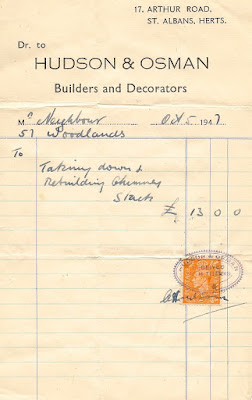So, what might we be looking at, and where? In this case we are looking at a group of semi-detached homes in Woodland Drive, which were constructed by the building firm of Arthur Welch. As they were completed between 1938 and 1940, their first occupants will have felt proud to finally own their own castle.
The little story which follows is recalled as a result of old documents which have been retrieved; the kind which include letters, copies of forms, orders and receipts, from people who never threw anything away!
There wasn't an extensive aerial bombardment in St Albans during the Second World War, so those events which did exist definitely stood out, and one in November 1940 obliterated one house and severely damaged three others in Beaumont Avenue. Four people lost their lives, either at the scene or later in hospital.
 |
| "For taking down and rebuilding dangerous chimney." |
During the months which followed the householders in nearby Woodland Drive north began to notice something awry with the chimney stacks connecting the kitchen solid fuel boilers at the side of the properties. A number of cracks began to appear; although in a few cases these cracks failed to materialise until later in the war or afterwards, even though there were no further bomb drops in the area.
Was this a weakness in the workmanship of the building company? Or was it the Beaumont Avenue bomb blast which weakened the structures? Of course, the builder blamed the war, and the local representative from the War Damage Department claimed a construction fault that today might have been rectified under the NHBC ten-year guarantee.
 |
| £13 in 1947. |
Once started, an inspection took place, followed by an application for permission to undertake remedial work – materials and manpower were in short supply even in the early years of Peace. If approved, the householder then engaged a builder to provide an estimate of cost. The War Damage Department then spent some time deciding whether the cost was within the approved limits; if so, giving its authority to proceed with the repair. However, the bill, paid for initially by the householder, was sent to the approved insurance company.
 |
| Sorry, you're too late! |
Today, of course, it is likely that none of the chimneys are still in place, gone when extensions were added or modern heating systems made the chimneys unnecessary. But if they had survived, and you looked upwards, it is just possible that you might notice a more modern piece of brickwork than the age of the house might suggest. Ah well!

No comments:
Post a Comment